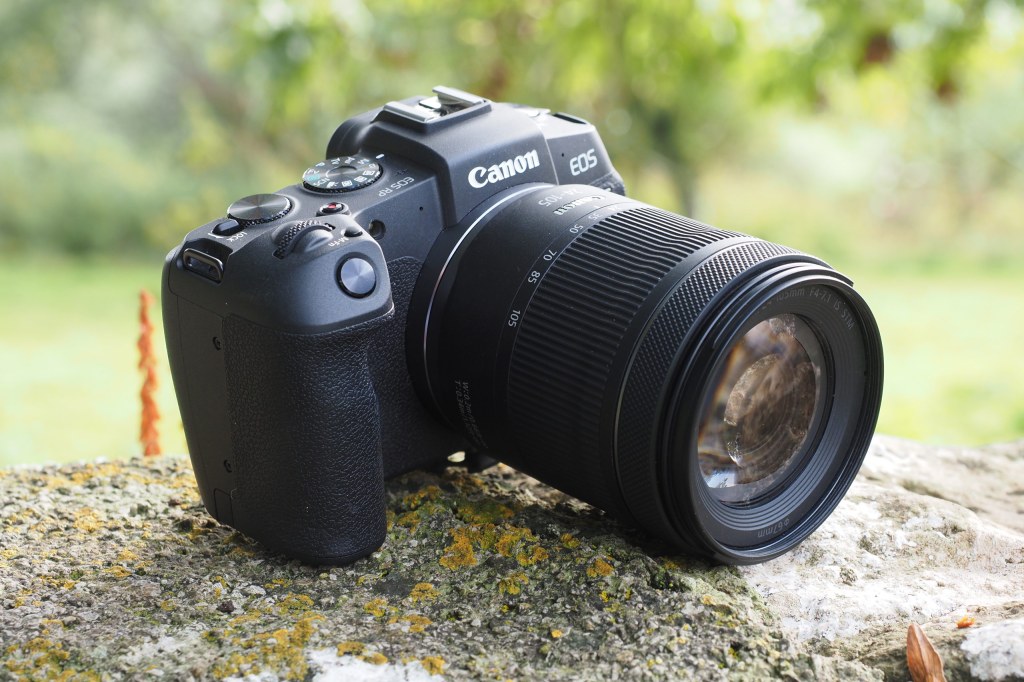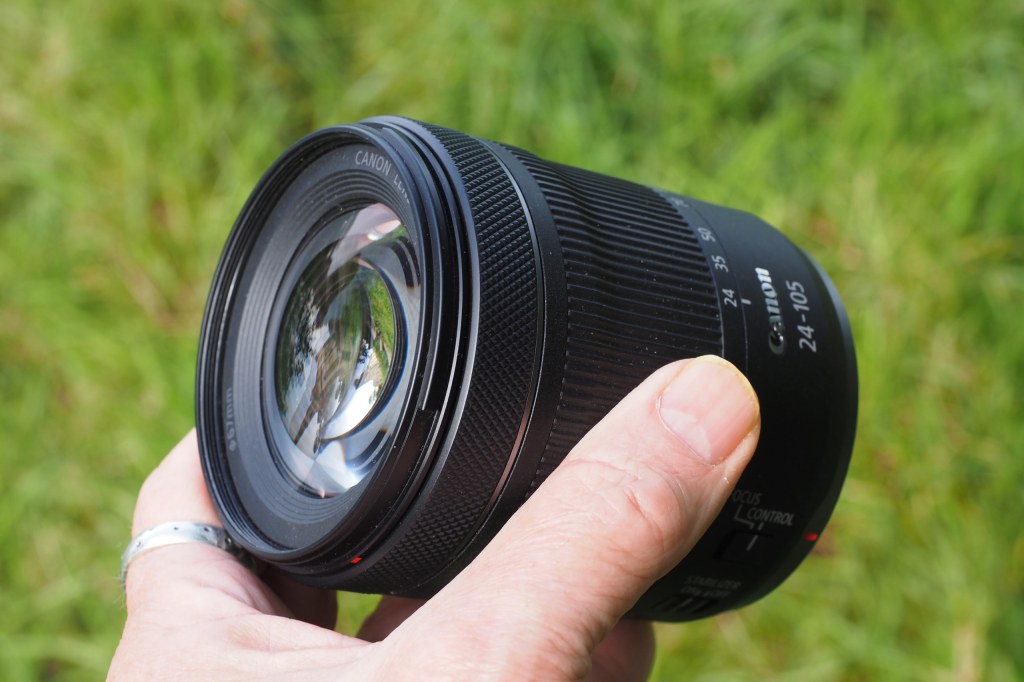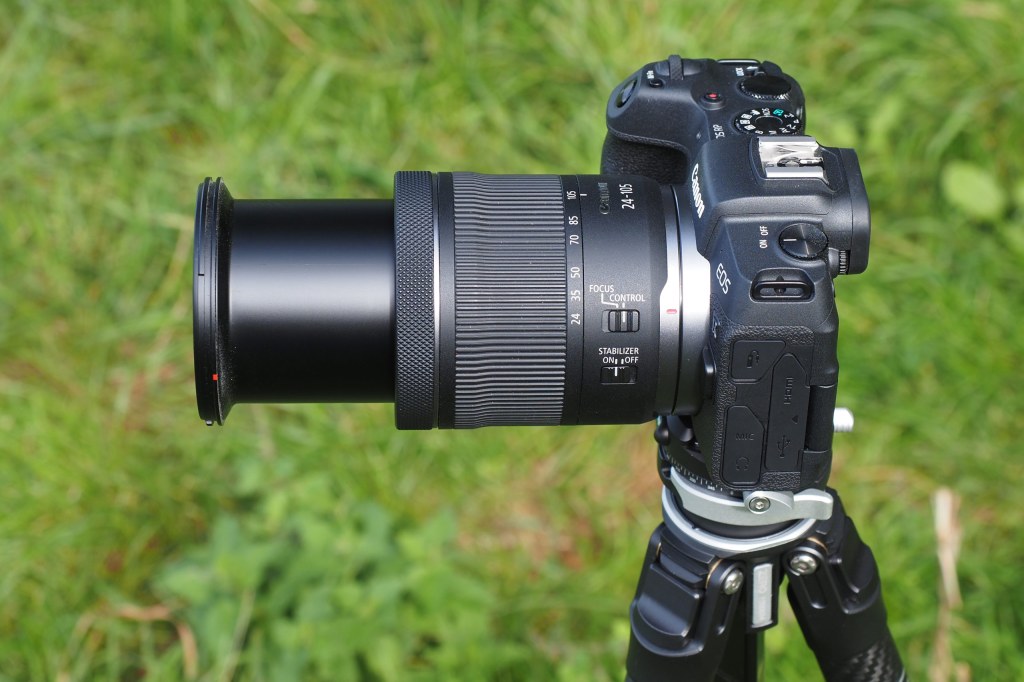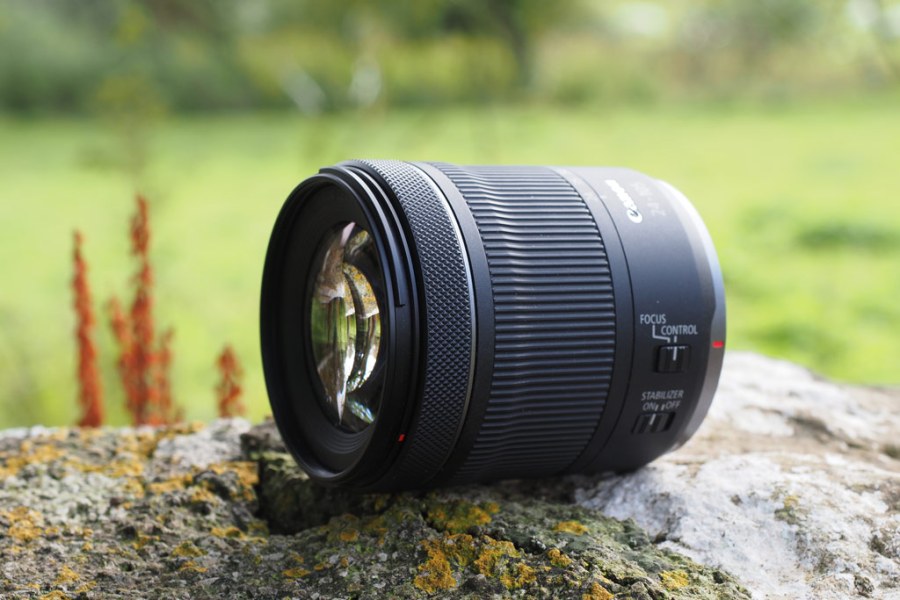The Canon RF 24-105mm F4-7.1 IS STM is a kit lens option for full frame Canon R series cameras. It’s commonly bundled with the Canon EOS RP, Canon EOS R6 and EOS R6 Mark II models, but is also sold separately.
Canon RF 24-105mm F4-7.1 IS STM – At a glance
- $299 / £359
- Standard zoom lens
- For Canon EOS R cameras
- Aperture range f/4-7.1 – f/22-40
- 20-34cm minimum focus distance
- 67mm filter size
- 76.6 x 88.8mm long, 395g
- Combined Focus/Control ring
- 5-stop optical image stabilisation

The RF 24-105mm F4-7.1 IS STM is the ideal kit lens for lighter full frame Canon EOS bodies like the EOS RP and EOS R8. Image credit: Rod Lawton
24-105mm lenses are popular as more versatile, longer-range standard zooms for full frame cameras, and most camera makers offer them. In fact, Canon makes two. There is a more expensive and heavier constant-aperture RF 24-105mm F4 L IS USM lens that’s similar to offerings from other camera brands. But the RF 24-105mm F4-7.1 IS STM reviewed here is unusual in being a lot lighter and a lot cheaper, and designed for users who want the same focal range but don’t want to spend professional lens money.
Canon RF 24-105mm F4-7.1 IS STM – Features
There is one very obvious compromise in the design of the Canon RF 24-105mm F4-7.1 IS STM to keep down the weight and the cost, and this is the variable maximum aperture, which shrinks from f/4 at the 24mm end of the zoom range to f/7.1 at 105mm.

The limited maximum aperture at longer focal lengths does restrict background blur somewhat, but it’s still very strong at closer focusing distances. Image credit: Rod Lawton
This means you have less control over depth-of-field and background blur at longer zoom settings, and you may also have to use slower shutter speeds or higher ISO settings to compensate for the smaller available lens apertures. This isn’t necessarily a problem, especially in regular outdoor lighting, where you will often be shooting at smaller apertures anyway.

With a weight of just 395g, the RF 24-105mm F4-7.1 IS STM is very light for a full frame lens with this focal range. Image credit: Rod Lawton
What you gain is a smaller and lighter lens that balances much better on compact Canon mirrorless bodies like the EOS RP and Canon EOS R8. With a length of 88.8mm and a weight of just 395g, the RF 24-105mm F4-7.1 IS STM is much easier to handle and carry around than usual for a 24-105mm lens. In comparison, the F4 L version is 107mm long and weighs 700g.

Full frame 24-105mm lenses are typically large and bulky, and the RF 24-105mm F4-7.1 IS STM is a smaller and lighter alternative. Image credit: Rod Lawton
Canon’s lower-end mirrorless bodies don’t have in-body stabilisation, but Canon typically incorporates optical stabilisation into its lenses, including this one. Canon says its IS mechanism offers up to 5 stops of shake compensation.

The in-built image stabilizer is rated at 5 stops of compensation and it gets very close to that in real-world shooting, too. Image credit: Rod Lawton
The RF 24-105mm F4-7.1 IS STM also has a customisable control ring, a standard feature on Canon RF lenses. This can be used either for focusing or to control one of several camera settings. I set it to control the aperture. There’s a sliding Focus/Control switch on the side of the barrel to swap between the Focus and Control modes.

The 67mm filter ring is a fairly common size and the front element does not rotate during focusing, so filter use is straightforward. Image credit: Rod Lawton
The front of the lens has a 67mm filter thread, which is a common size. The lens has an internal focus mechanism, and the front of the lens doesn’t rotate during focusing, so you won’t have any trouble using graduated filters or polarizers.
Canon RF 24-105mm F4-7.1 IS STM – Build and handling
The RF 24-105mm F4-7.1 IS STM doesn’t seem an especially small lens, until you compare it to a typical 24-105mm f/4 standard zoom, including Canon’s own. It’s then that you see just how much weight and bulk has been saved with its variable-aperture design. If you still think it’s too large, then the only real alternative is the retracting Canon RF 24-50mm F4.5-6.3 IS STM kit lens, but that’s a lot more limited in its focal length range.

The RF 24-105mm F4-7.1 IS STM has an inner barrel that extends at longer zoom settings, but the zoom action itself is smooth and light. Image credit: Rod Lawton
Although it’s one of Canon’s cheaper ‘consumer’ lenses, the RF 24-105mm F4.5-7.1 IS STM actually feels very well made. The finish feels good, the zoom ring has even resistance across its fairly short throw, and there’s no ‘zoom creep’ from the weight of the lens if you tip the camera forward. When you choose a zoom setting, it stays there.

The zoom ring is a good size, but the RF 24-105mm F4-7.1 IS STM has a single control ring for both manual focusing and custom controls. Image credit: Rod Lawton
The Focus/Control ring has a very nice feel to it too. It’s a focus-by-wire system so there’s no distance scale and no hard end stops to the focus travel, but it’s smooth and light and has no play or ‘slop’. It’s perfect for manual focusing, but the lack of a click action does make it feel a little vague for controlling camera settings, such as the aperture. Some RF lenses have dual control rings, but not this one, so this single ring has to do both jobs.

The build quality feels good for a lens at this price, and includes a metal mounting plate at the rear. Image credit: Rod Lawton
The overall feeling of quality extends to the metal mounting plate on the rear (the cheaper RF 24-50mm F4.5-6.3 IS STM lens has a plastic plate). This might be one of Canon’s cheaper lenses, but it has a real feeling of quality both in the materials used and the way it handles.
One small annoyance is that there’s no AF/MF switch on the lens barrel. If you want to focus manually you have to set the MF mode on the camera body before you can use the control ring for focusing.
Canon RF 24-105mm F4-7.1 IS STM – Autofocus
Canon’s STM autofocus system is very fast and effectively silent. It takes a fraction of a second to travel from furthest to nearest focus even at maximum zoom, and in normal use it’s practically instantaneous. It moves smoothly from one focus point to another with no hesitation or ‘hunting’ when it gets there. Autofocus performance depends a lot on the camera used, of course, but it’s clear from testing it on the EOS R8 that this lens can keep up with Canon’s latest and fastest bodies extremely well for a non-professional lens.

The side of the lens barrel has switches for the built-in image stabilizer and for swapping the front ring action between focusing and custom controls. Image credit: Rod Lawton
The same applies to video, where the RF 24-105mm F4-7.1 IS STM offers extremely smooth and progressive focus shifts. Here its silent operation is even more valuable, especially if you’re using the camera’s on-board mic, which will be very prone to picking up any operational sounds.
It may seem as if the focus shifts in video can be a little too leisurely, but the answer lies in the camera settings, where you can adjust the speed at which the camera refocuses. Many videographers prefer slower, more ‘cinematic’ focus changes, but you can speed them up – it’s not a limitation of the lens.
Canon RF 24-105mm F4-7.1 IS STM – Performance
Some of Canon’s consumer-level RF lenses rely heavily on digital lens corrections, and this is one of them. Uncorrected, any images shot at the shortest 24mm focal length will have such strong barrel distortion that the corners of the image turn black. However, corrections are applied automatically to in-camera JPEGs and most raw processing software – Lightroom and Adobe Camera Raw included – will automatically apply a lens correction profile. The only time these necessary lens corrections become an issue is when you use raw software that doesn’t have a matching correction profile – at the time of writing, Capture One does not.

The image quality remains very good indeed, right across the focal range. Many lenses soften up at longer focal lengths, but the RF 24-105mm F4-7.1 IS STM stays crisp and sharp. Image credit: Rod Lawton
The question is whether Canon’s combination of optical and digital corrections produces better images, and the results from the RF 24-105mm F4-7.1 IS STM are really impressive for a lens with this focal range and price point.

The RF 24-105mm F4-7.1 IS STM is a great ‘walkabout’ lens, offering a usefully wide angle of view at its shortest focal length. Image credit: Rod Lawton
In fact, JPEGs straight from the camera are corrected so well that they are effectively aberration-free. There’s no distortion, no chromatic aberration and no corner shading. What’s more, they show impressive edge sharpness, though the definition at the extreme edges can fall away a little at 24mm.

You can sometimes see slight softening of edge detail at the widest 24mm setting, but you have to zoom in a long way to see it. Image credit: Rod Lawton
With longer range zooms like these, especially inexpensive ones, you might be used to avoiding the longest focal lengths where possible or expecting some softness. Not here. Images shot at 105mm on the RF 24-105mm F4-7.1 IS STM look as crisp as those shot at 24mm. If there is some fall-off in quality, it’s so slight that only the most determined pixel-peepers will care.

This shot was taken at 105mm and with a handheld exposure of 1/5 sec – the image stabilization in the RF 24-105mm F4-7.1 IS STM is very effective. Image credit: Rod Lawton
In fact, compared against Canon’s pro level RF 24-105mm F4 L IS USM lens, this one actually looks more consistent for edge-to-edge sharpness.
The image stabilisation is extremely impressive too. Canon claims up to five stops of shake compensation, and this lens gets pretty close to that in everyday shooting – you can’t always say that about manufacturers’ stabilisation claims. If you choose a Canon EOS RP or EOS R8 you might be worried about their lack of in-body-stabilisation, but with this lens, you can stop worrying.

The RF 24-105mm F4-7.1 IS STM produces extremely crisp-looking fine detail and textures. Image credit: Rod Lawton
It also does a good job of stabilising hand-held video, or at least, the micro-jitters caused by hand holding. It’s less effective at smoothing out jerky camera movements, but then that’s why so many videographers use gimbals.
Canon RF 24-105mm F4-7.1 IS STM – Verdict
If you judge this lens solely on its specifications, you might be expecting a cheaply made lens of very average performance and limited usefulness for serious photographers. That’s not what you get.

This picture needed negative EV compensation to preserve the colours, but while it’s possible to use the lens control ring to do this, its ‘clickless’ action feels better suited to focusing, not camera settings. Image credit: Rod Lawton
Canon’s use of software corrections produces a lens that punches well above its weight for image quality. You might choose the more expensive Canon RF 24-105mm F4 L IS USM for its constant maximum aperture and build quality, but you’d be unwise to expect better images than this lens provides.

The lines in this image taken at 24mm are dead straight, but the reality is that the RF 24-105mm F4-7.1 IS STM relies heavily on digital corrections. Image credit: Rod Lawton
There are some disadvantages, notably the variable maximum aperture. This limits what you can do with manual aperture/iris control in both stills photography and video, as the apertures available will change with the zoom setting. It also means that the further you zoom, the more you’ll be forced towards slower shutter speeds or higher ISO settings.

Indoor and low-light shots do become more of a challenge when the maximum aperture is restricted. This shot had to be taken at ISO 25600. Image credit: Rod Lawton
But as an affordable, portable, walkaround standard zoom, the RF 24-105mm F4-7.1 IS STM is pretty exceptional. Its autofocus is silent, smooth and very fast, and its optical stabilization is equally impressive. And for filmmakers, the variable maximum aperture might be a nuisance, but the smooth and silent focus transitions are a real bonus.

Having a kit lens with a longer maximum focal length means you can get more creative with your compositions. Image credit: Rod Lawton
Very often, ‘consumer’ lenses are built down to a price and are no better than they have to be. However, the Canon RF 24-105mm F4-7.1 IS STM might indeed be built down to a price, but it’s way better optically and operationally than its modest price suggests.

Further reading:
Follow AP on Facebook, Twitter, Instagram, YouTube and TikTok.







